- sale
- new items
- lovely beads
- wedding beads
- beads for teens
- for custom order
- newsletter
- recognition
- testimonials
- birthstones
- zodiac signs
- jewelry guide
SHOP BAG
![]() in your bag 0 items
in your bag 0 items
One of the July stones is carnelian. It has long held a presence in world history and the beliefs and customs of ancient civilizations. From Europe, to Asia, to the Middle East, archaeologists have found examples of carnelian use.
Carnelian was recovered from Bronze Age Minoan layers at Knossos on Crete in a form that demonstrated its use in decorative arts; this use dates to approximately 1800 BC. Ancient Greeks and Romans called it Sardius and used the stone for cameos and intaglios. Carnelian was used widely during Roman times 2000 years before the present era to make signet or seal rings for imprinting a seal with wax on correspondence or other important documents (hot wax does not stick to carnelian).
Sard (the brownish red variety of carnelian) was used for Assyrian cylinder seals, Egyptian and Phoenician scarabs, and early Greek and Etruscan gems. In more modern times, Goethe attributed the powers of protection against evil, of continuation of hope and comfort, and of good luck.
The greatest myths surrounding the stone carnelian, come from the Egyptian Culture. The Egyptian goddess Isis protected the dead with a carnelian amulet named Thet. After being soaked in Ankhami flower water, on a Sycamore plinth (a type of tile) and placed on the body of the deceased, Isis would grant the person protection from harm while moving through the afterlife.
The stone also appears In Hebrew Mythology; Aaron's breastplate included a carnelian stone. Buddhists in China and India created amulets inlaid with carnelian and other semi-precious stones, ascribing to them powers of protection and utilizing them for many rituals. In India, Hindu astrology names carnelian as the secondary stone of Scorpios.



